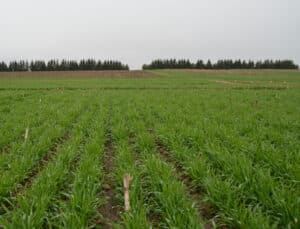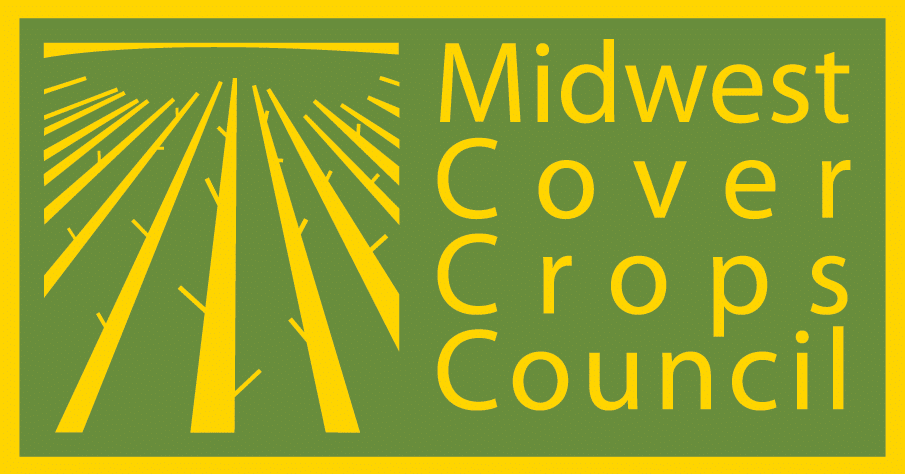Midwest Cover Crops Council (MCCC-125)
University of Guelph (SAG-FS-20-001)
This publication is intended to provide a starting point for farmers who are new to growing cover crops. With experience, farmers may fine-tune the use of cover crops for their systems.
Introduction
The following recipe provides an introductory approach to integrating a cover crop after corn silage harvest and before planting soybean as the next crop.
Planning and Preparation
- Planning—Read about cover crops. Go to field days. Start small. Be timely. Prioritize management based on purpose and objectives.
- Residual corn herbicides—Read the product label to identify any recropping restrictions for planting fall rye (Secale cereale L.) after silage corn harvest. Rye should not be grazed or harvested for forage unless product labels explicitly permit the use of an underseeded, treated crop as feed or the recropping restrictions are followed. (See Table 4-4, Herbicide Crop Rotation and Soil pH Restrictions—Field Crops, in Publication 75A, Guide to Weed Control: Field Crops in Resources.)
- Seed purchase—Order rye seed early, usually by early summer. Use good quality seed from a reputable seed dealer. Bin-run seed doesn’t have guaranteed germination and may come with unwanted weed seeds. Consider doing a germination test before planting and adjust seeding rates accordingly.
Fall Work
- Fall manure—It generally works best to plant cover crops following manure application via injection or surface application and incorporation. Nevertheless, so long as soil conditions are fit, manure can be applied by dragline or tanker once rye has passed the 2-3 leaf stage. This is not likely to damage the rye since the growing point remains below the ground in the fall.
- Tillage or no-tillage—Generally, it is easier to integrate cover crops into no-tillage or strip-tillage systems. If tillage is necessary to incorporate manure or smooth the seedbed after corn silage harvest, it should take place prior to rye seeding.
- Timing of planting—Plant rye as soon as possible after silage corn harvest and at least two weeks before the average hard frost date (-2°C). If planting later than mid-October, double the seeding rate.
- Seeding rate—Seed at a rate of 40–90 lbs/acre (assuming a germination rate of 85% or greater). Seeding rates should be increased by 50% if broadcasting and incorporating or be doubled if just broadcasting. If the rye will be grazed or harvested as a silage crop in the spring, use a rate of 100–170 lbs/acre.
- Planting method—Drill to a depth of 1–1.5 inches or broadcast with shallow incorporation to less than 1.5 inches. Aerial or other broadcast seeding is an option for earlier establishment into standing corn with some risk of poor or inconsistent establishment. Overly wet or dry conditions after aerial seeding or presence of slugs will limit success.
- Other fall operations—Use a current soil test (no older than four years) to determine lime or nutrient requirements for next year’s crop. If needed, thoroughly incorporate before seeding the rye cover crop.

Spring Work
- Termination timing—Terminate the rye in the spring when plants are 6 to 12 inches tall and actively growing or about two weeks before planting soybeans—whichever comes first. In a wet or windy spring, be ready to take advantage of any break in the weather and/or use low axle weight sprayers.
- Termination herbicide—Rye can be terminated with glyphosate after the rye begins growing in the spring (see Publication 75A, Guide to Weed Control: Field Crops in Resources). Effectiveness and speed of termination improves if rye is rapidly growing and air temperatures are warmer (>15°C). Larger rye, rye past the boot stage, or rye sprayed during cooler weather can be more difficult to kill, may require higher glyphosate rates, and will die more slowly.
- Option to harvest rye as a silage crop—Some growers may be interested in harvesting rye as an additional silage crop. Make sure all herbicide restrictions are followed. Also, this will typically delay the planting date for the next crop, but any fall-applied nutrients can be counted toward the rye crop in nutrient management planning. (See Resources for additional information on rye forage management.) Be sure to control rye regrowth.
- Soybean planting—Almost all modern planters and drills, with some modifications, are capable of planting soybean into a rye cover crop. Check that soybean seed is planted into moisture and the slot is closed shortly after beginning to plant; usually some adjustments are needed.
- Scouting—After planting, scout for soybean emergence, stand establishment, and weed control. Rye residue can delay annual weed emergence, which may shift the timing of post-emergence herbicides.
Resources
Cover Crop Selector Tool —available from Midwest Cover Crops Council
Publication 811, Agronomy Guide for Field Crops (OMAFRA)
Publication 75A, Guide to Weed Control: Field Crops (OMAFRA)
Cover Crops (OMAFRA web publication)
Double Cropping Fall Rye for Extra Forage (OMAFRA web publication)
Get a Jump on Early Spring Forage (OMAFRA web publication)
Authors
Cameron Ogilvie, University of Guelph; Jake Munroe, OMAFRA; Mike Cowbrough, OMAFRA; Christine O’Reilly, OMAFRA; Laura Van Eerd, University of Guelph; Anne Verhallen, OMAFRA
Reviewers and Contributors
Dale Cowan, AGRIS Co-operative Ltd.; David Hooker, University of Guelph; Peter Johnson, Real Agriculture; Darren Robinson, University of Guelph; Peter Sikkema, University of Guelph; and François Tardif, University of Guelph
The Midwest Cover Crops Council (www.https://www.midwestcovercrops.org) aims to facilitate widespread adoption of cover crops throughout the U.S. Midwest and Ontario by providing educational/outreach resources and programs, conducting new research, and communicating about cover crops to the public.
Funding for this project was provided by McKnight Foundation.
August 2020
The U.S. Department of Agriculture (USDA) prohibits discrimination in all its programs and activities on the basis of race, color, national origin, age, disability, and where applicable, sex, marital status, familial status, parental status, religion, sexual orientation, genetic information, political beliefs, reprisal, or because all or a part of an individual’s income is derived from any public assistance program. (Not all prohibited bases apply to all programs.) Persons with disabilities who require alternative means for communication of program information (Braille, large print, audiotape, etc.) should contact USDA’s TARGET Center at (202) 720-2600 (voice and TDD). To file a complaint of discrimination write to USDA, Director, Office of Civil Rights, 1400 Independence Avenue, S.W., Washington, D.C. 20250-9410 or call (800) 795-3272 (voice) or (202) 720-6382 (TDD). USDA is an equal opportunity provider and employer. ©2020 by MCCC. All rights reserved.

